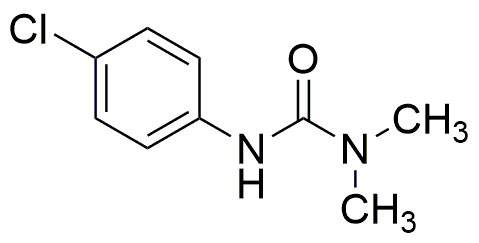3-(4-Chlorophenyl)-1,1-dimethylurea is widely utilized in research focused on:
- Agricultural Chemistry: This compound acts as a herbicide, effectively controlling weed growth in various crops, thus enhancing agricultural productivity.
- Pharmaceutical Development: It serves as a key intermediate in the synthesis of pharmaceuticals, particularly in the development of anti-inflammatory and analgesic drugs.
- Environmental Studies: Researchers use it to study the degradation of chemical compounds in soil and water, helping to assess environmental impact and safety.
- Analytical Chemistry: It is employed in analytical methods for detecting and quantifying pesticide residues, ensuring food safety and compliance with regulations.
- Biochemical Research: The compound is utilized in studies related to enzyme inhibition, providing insights into metabolic pathways and potential therapeutic targets.
Informations générales
Propriétés
Sécurité et réglementation
Applications
3-(4-Chlorophenyl)-1,1-dimethylurea is widely utilized in research focused on:
- Agricultural Chemistry: This compound acts as a herbicide, effectively controlling weed growth in various crops, thus enhancing agricultural productivity.
- Pharmaceutical Development: It serves as a key intermediate in the synthesis of pharmaceuticals, particularly in the development of anti-inflammatory and analgesic drugs.
- Environmental Studies: Researchers use it to study the degradation of chemical compounds in soil and water, helping to assess environmental impact and safety.
- Analytical Chemistry: It is employed in analytical methods for detecting and quantifying pesticide residues, ensuring food safety and compliance with regulations.
- Biochemical Research: The compound is utilized in studies related to enzyme inhibition, providing insights into metabolic pathways and potential therapeutic targets.
Documents
Fiches de données de sécurité (FDS)
La FDS fournit des informations de sécurité complètes sur la manipulation, le stockage et l’élimination du produit.
Spécifications du produit (PS)
Le PS fournit une description complète des propriétés du produit, notamment sa composition chimique, son état physique, sa pureté et les exigences de stockage. Il détaille également les plages de qualité acceptables et les applications prévues du produit.
Certificats d'analyse (COA)
Recherchez des certificats d'analyse (COA) en saisissant le numéro de lot du produit. Les numéros de lot et de lot se trouvent sur l'étiquette d'un produit, après les mots « Lot » ou « Lot de fabrication ».
Numéro de catalogue
Numéro de lot/série
Certificats d'origine (COO)
Ce certificat d'exploitation confirme le pays dans lequel le produit a été fabriqué, et détaille également les matériaux et composants utilisés et s'il est issu de sources naturelles, synthétiques ou autres sources spécifiques. Ce certificat peut être requis pour les douanes, le commerce et la conformité réglementaire.
Numéro de catalogue
Numéro de lot/série
Fiches de données de sécurité (FDS)
La FDS fournit des informations de sécurité complètes sur la manipulation, le stockage et l’élimination du produit.
DownloadSpécifications du produit (PS)
Le PS fournit une description complète des propriétés du produit, notamment sa composition chimique, son état physique, sa pureté et les exigences de stockage. Il détaille également les plages de qualité acceptables et les applications prévues du produit.
DownloadCertificats d'analyse (COA)
Recherchez des certificats d'analyse (COA) en saisissant le numéro de lot du produit. Les numéros de lot et de lot se trouvent sur l'étiquette d'un produit, après les mots « Lot » ou « Lot de fabrication ».
Numéro de catalogue
Numéro de lot/série
Certificats d'origine (COO)
Ce certificat d'exploitation confirme le pays dans lequel le produit a été fabriqué, et détaille également les matériaux et composants utilisés et s'il est issu de sources naturelles, synthétiques ou autres sources spécifiques. Ce certificat peut être requis pour les douanes, le commerce et la conformité réglementaire.


